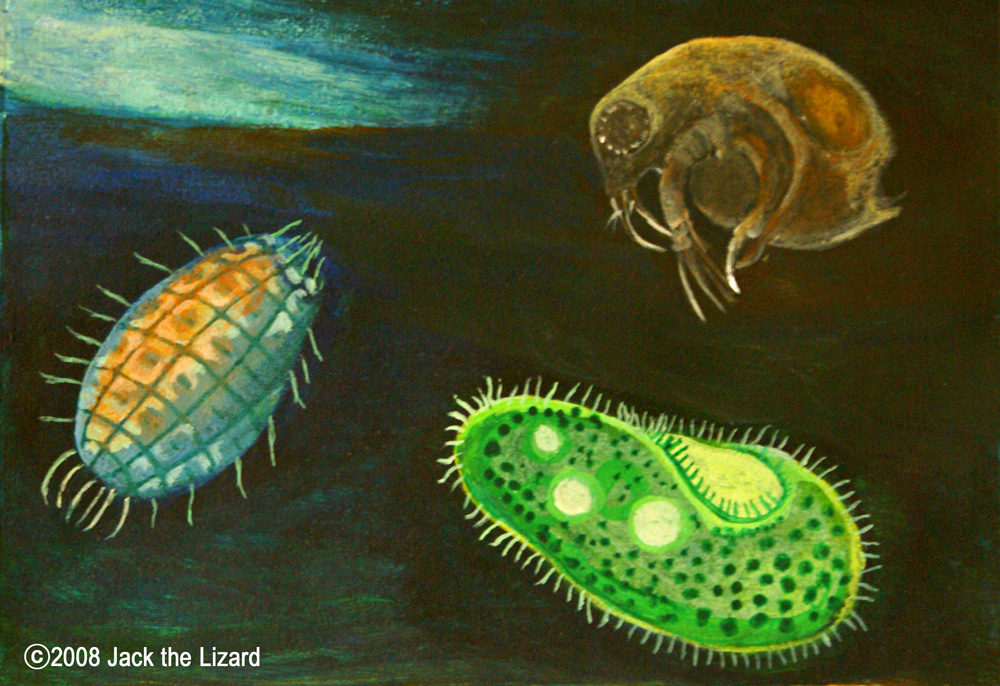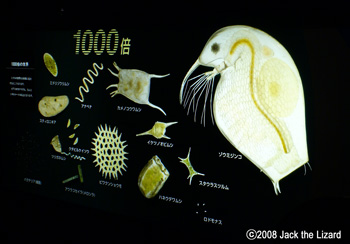
|
|
|
|
|
Jack the Lizard is on YouTube |
July 16, 2008
Lake Biwa Museum opens workshop for students. The students go out to the lake just out side of the museum to collect planktons. They are hardly seen by eyes, so students use the electron microscopes to watch and draw each of them in the laboratory. Several sample photos of planktons are prepared by the museum curators. So students can recognize what they are actually watching through the microscopes. At the end, the museum curators explain each of phytoplankton and zooplanktons.
Today, many of the students collected anabaena and microcystis. They are genus of filamentous cyanobacteria. The cities and villages have been rapidly developped and nutritious drain flow into rivers and lakes. That propagates cyanobacteria and float surface of the lake which looks like dropping green ink on water. The cyanobacteria produce neurotoxins, which is toxic and harmful to environment, plants and animals.
The plankton shown on the TV monitor is Noro (Leptodora kindtii), a kind of water flea. It looks like a tiny shrimp, which has single compound eye.

The curator Taisuke Otsuka is the specialist of phytoplankton. Phytoplankton doesn’t move by itself, so it is not easy for students to find. He shows the features of the planktons and explains its' ecology.

What is Plankton anyway?
Plankton is defined as a creature which has limited ability to move by itself or just float in the water.
So the 1/1000 millimetre long Picoplankton is a plankton, and 2 meters long Megaplankton such as jellyfish is a plankton as well.
Is the Slipper Animalcule male or female?
It is said that there are more than several thousands different kinds of plankton only in Lake Biwa. However, only about 800 of those have been listed up. Plankton can be normally divided in two groups. Phytoplankton and Zooplankton. To get nutrition, phytoplankton photosynthesizes and zooplankton feeds on other plankton. Each of them has different size in different colour.
One is in pink to protect itself from sunshine, and another is in red dyed by food. Some stick sand grains to create nest, and another has mucus around its body to protect from predator.
Paramecium, Slipper Animalcule has 3 genders A, B, and C!! unlike most of the beings on the earth which have two genders, male and female.

Levicoleps biwae eats dead water fleas. It is like hyena in lake.
Super UnicellularIt is thought that life on earth began 3 billion years ago. It is still unknown what exactly the first being emerged was. It is commonly understood that the first being produced its offspring which produced its' offspring, and gradually increased variation between organisms, then each of them branched out to millions of species. There are many different kinds of microscopic organisms which evolved in the different way from human, mammalians, fowl, fish and so on. They are unicellular, which consist of only one cell. Their sensory system is not divided into mouth, nose, eye, ear, and so on. But unicellular has ability to sense. One proceeds towards light, another recognizes smell and another feels magnetism. "Unicellular is like a computer chip. One cell has all functions of the sensory systems. It is likely to be misunderstood that unicellular have fewer abilities, but that is wrong", said Yasushi Kusuoka, the Senior Research Scientist. |

Gallery C exhibits the culture and life style of the people around the Lake Biwa. The plankton zone in the gallery was expanded in March 2008 after renovation. |
Actually some unicellular plankton has amazing ability. For example, one amoeba never die. If the cell is damaged or lost part of it, it can fix the damage by itself. It reproduces via mitosis and cytokinesis. When it becomes old, the amoeba can be merged with younger one to be a younger unicellular. Paramecium bursaria, a kind of slipper animalcule, can survive only with sun shine. Paramecium bursaria has symbiotic algae, chlorella. Paramecium bursaria feeds on organic substance which is produced by chlorella via photosynthesis. The chlorella feeds on phosphorus and nitrogen which is excretions of the Paramecium bursaria.

The senior research scientist Kusuoka released his discovery of the new kind of ciliophora, which is a kind of the slipper animalcule. The ciliophora was collected from the lake shore close to the museum. Kusuoka studied the ciliophora with Prof. Dr. Wilhelm Foissner from University of Salzburg and Associate Professor Tomoyuki Nagano from Miyagi University of Education and they have determined that it is a new species. His dissertation was published on International Society of Protistologists' scientific journal, "Journal of Eukaryotic Microbiology" in June. The ciliophora was named Levicoleps biwae by Dr. Foissner. Levi means "smooth" and Biwae means "Lake Biwa". Lake Biwa has long history. It is thought that Levicoleps biwae was emerged in the ancient times. It may have some clues to find out about specialisation in the ancient lake.

Plankton supports a lot of lives in water. When you take a look at lakes, liver or ocean, plankton is too tiny for our naked eyes. If you get interested in the micro world, you would find that there is a huge wonder world.
The planktons in the illustrations are depicted to show you the detail and not in the right size or ratio.